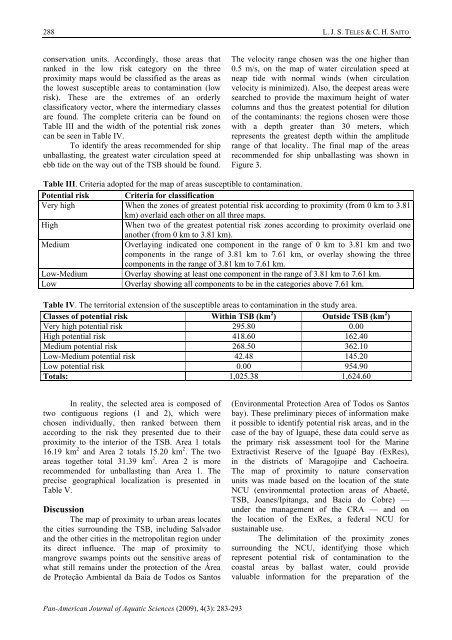Download full issue - PanamJAS
Download full issue - PanamJAS
Download full issue - PanamJAS
You also want an ePaper? Increase the reach of your titles
YUMPU automatically turns print PDFs into web optimized ePapers that Google loves.
288<br />
L. J. S. TELES & C. H. SAITO<br />
conservation units. Accordingly, those areas that<br />
ranked in the low risk category on the three<br />
proximity maps would be classified as the areas as<br />
the lowest susceptible areas to contamination (low<br />
risk). These are the extremes of an orderly<br />
classificatory vector, where the intermediary classes<br />
are found. The complete criteria can be found on<br />
Table III and the width of the potential risk zones<br />
can be seen in Table IV.<br />
To identify the areas recommended for ship<br />
unballasting, the greatest water circulation speed at<br />
ebb tide on the way out of the TSB should be found.<br />
The velocity range chosen was the one higher than<br />
0.5 m/s, on the map of water circulation speed at<br />
neap tide with normal winds (when circulation<br />
velocity is minimized). Also, the deepest areas were<br />
searched to provide the maximum height of water<br />
columns and thus the greatest potential for dilution<br />
of the contaminants: the regions chosen were those<br />
with a depth greater than 30 meters, which<br />
represents the greatest depth within the amplitude<br />
range of that locality. The final map of the areas<br />
recommended for ship unballasting was shown in<br />
Figure 3.<br />
Table III. Criteria adopted for the map of areas susceptible to contamination.<br />
Potential risk Criteria for classification<br />
Very high When the zones of greatest potential risk according to proximity (from 0 km to 3.81<br />
km) overlaid each other on all three maps.<br />
High<br />
When two of the greatest potential risk zones according to proximity overlaid one<br />
another (from 0 km to 3.81 km).<br />
Medium<br />
Overlaying indicated one component in the range of 0 km to 3.81 km and two<br />
components in the range of 3.81 km to 7.61 km, or overlay showing the three<br />
components in the range of 3.81 km to 7.61 km.<br />
Low-Medium Overlay showing at least one component in the range of 3.81 km to 7.61 km.<br />
Low<br />
Overlay showing all components to be in the categories above 7.61 km.<br />
Table IV. The territorial extension of the susceptible areas to contamination in the study area.<br />
Classes of potential risk Within TSB (km 2 ) Outside TSB (km 2 )<br />
Very high potential risk 295.80 0.00<br />
High potential risk 418.60 162.40<br />
Medium potential risk 268.50 362.10<br />
Low-Medium potential risk 42.48 145.20<br />
Low potential risk 0.00 954.90<br />
Totals: 1,025.38 1,624.60<br />
In reality, the selected area is composed of<br />
two contiguous regions (1 and 2), which were<br />
chosen individually, then ranked between them<br />
according to the risk they presented due to their<br />
proximity to the interior of the TSB. Area 1 totals<br />
16.19 km 2 and Area 2 totals 15.20 km 2 . The two<br />
areas together total 31.39 km 2 . Area 2 is more<br />
recommended for unballasting than Area 1. The<br />
precise geographical localization is presented in<br />
Table V.<br />
Discussion<br />
The map of proximity to urban areas locates<br />
the cities surrounding the TSB, including Salvador<br />
and the other cities in the metropolitan region under<br />
its direct influence. The map of proximity to<br />
mangrove swamps points out the sensitive areas of<br />
what still remains under the protection of the Área<br />
de Proteção Ambiental da Baía de Todos os Santos<br />
(Environmental Protection Area of Todos os Santos<br />
bay). These preliminary pieces of information make<br />
it possible to identify potential risk areas, and in the<br />
case of the bay of Iguapé, these data could serve as<br />
the primary risk assessment tool for the Marine<br />
Extractivist Reserve of the Iguapé Bay (ExRes),<br />
in the districts of Maragojipe and Cachoeira.<br />
The map of proximity to nature conservation<br />
units was made based on the location of the state<br />
NCU (environmental protection areas of Abaeté,<br />
TSB, Joanes/Ipitanga, and Bacia do Cobre) —<br />
under the management of the CRA — and on<br />
the location of the ExRes, a federal NCU for<br />
sustainable use.<br />
The delimitation of the proximity zones<br />
surrounding the NCU, identifying those which<br />
represent potential risk of contamination to the<br />
coastal areas by ballast water, could provide<br />
valuable information for the preparation of the<br />
Pan-American Journal of Aquatic Sciences (2009), 4(3): 283-293
















